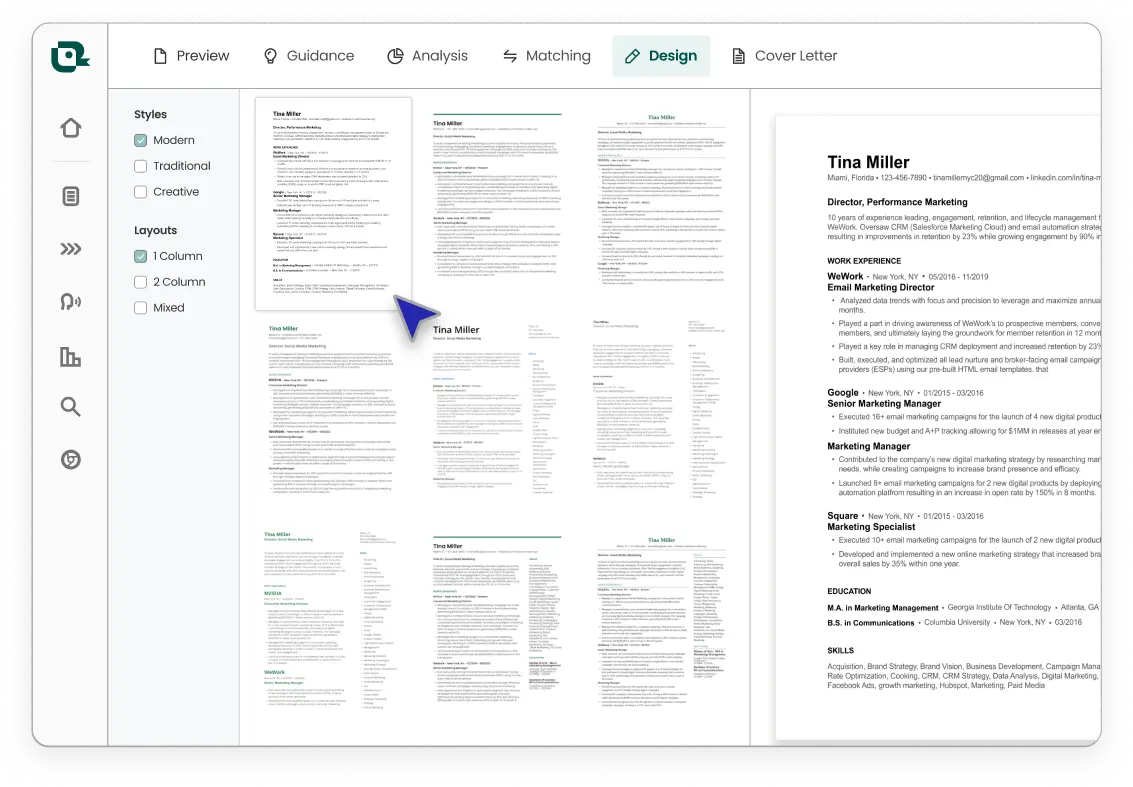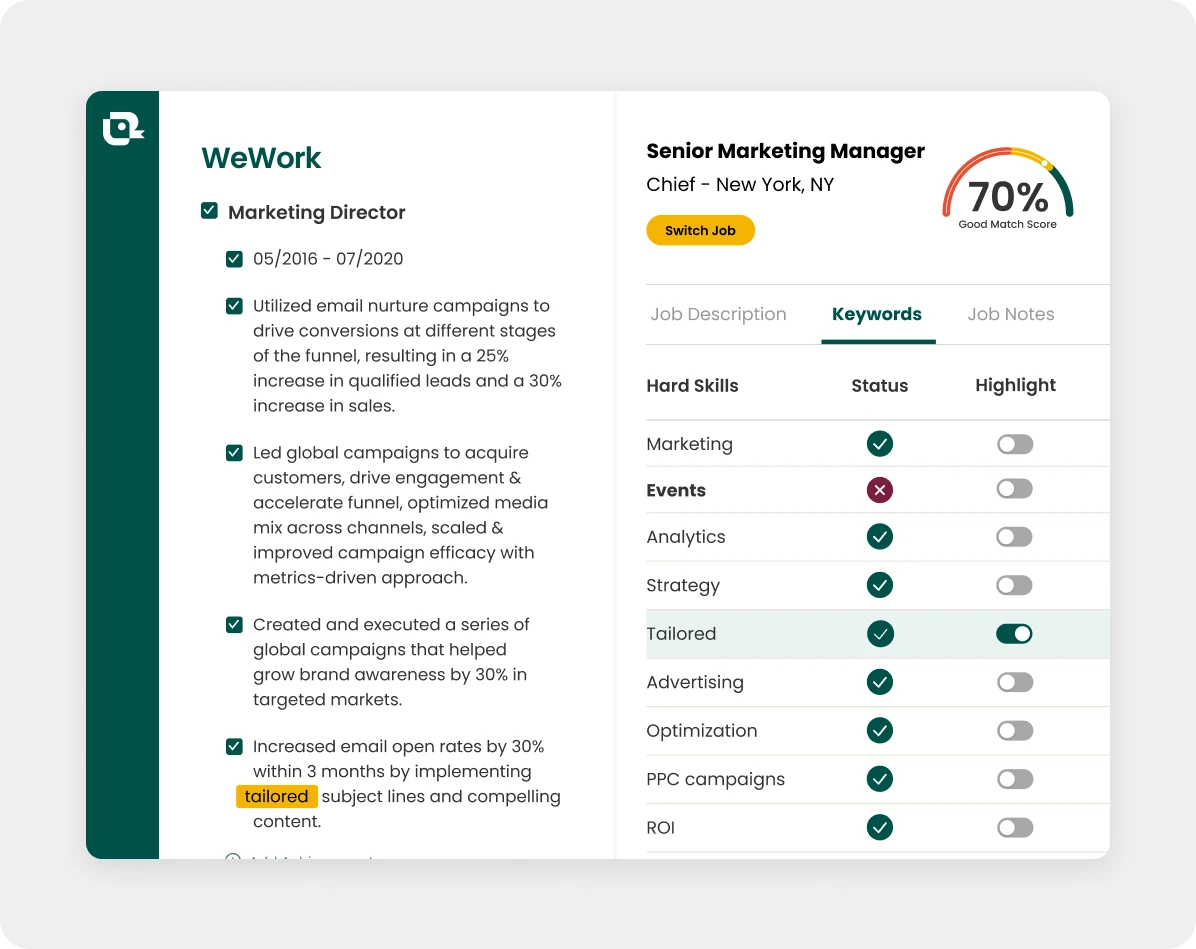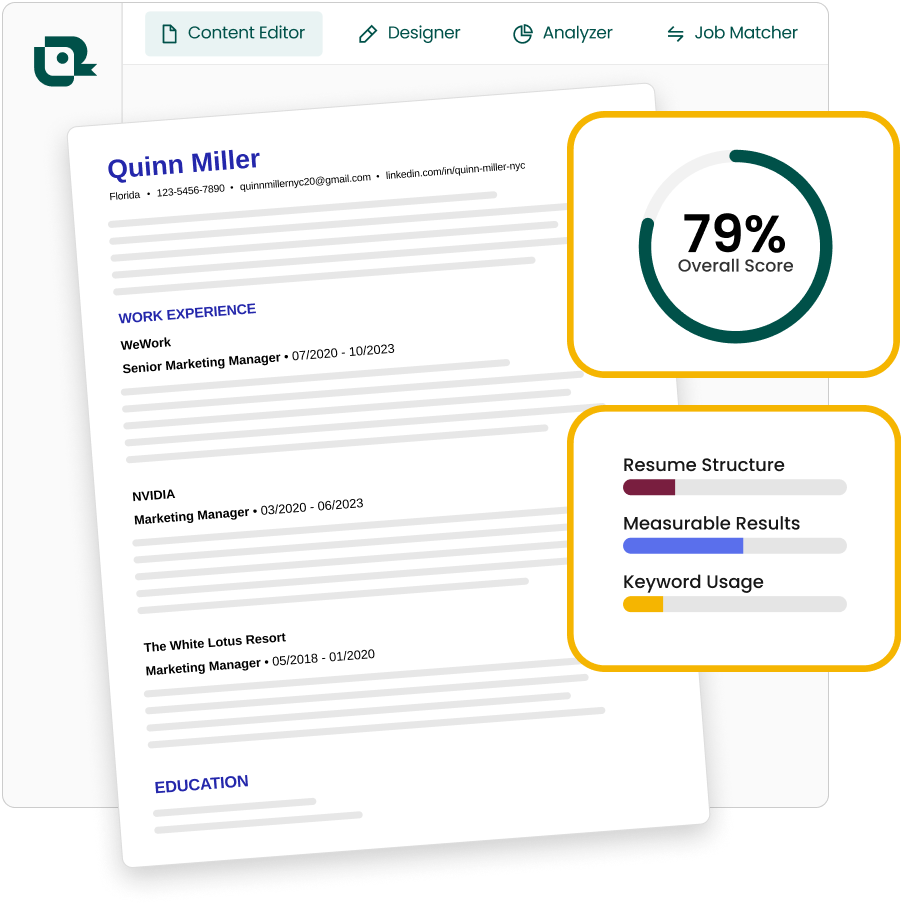3 key takeaways
- Shortening your resume can help a hiring professional see your value quickly.
- You can edit your resume content without sacrificing quality or your most valuable experiences.
- Teal’s AI Resume Builder stores your entire career history, so you never have to decide between deleting skills or experience and saving it for another opportunity.
Resume writing is hard. Writing a short resume often feels impossible. Balancing your experience and qualifications with the length of your content can leave you wondering how much is too much.
But here's the thing: hiring professionals don't have the time to read resume novels. Not only that, but an overly wordy resume can also be a red flag, signaling you’re not able to communicate or prioritize effectively.
But don't worry; shortening your resume doesn't mean sacrificing key skills. It's all about knowing what to include and what to leave out.
Below, you'll learn how to tell if your resume needs editing to condense it. You'll also learn how to shorten a resume and the best tools for streamlining your content without compromising what you bring to the table.
Looking to shorten your resume to include only relevant details? Sign up for Teal's free resume creator and do it quickly today.
Why you should shorten a resume
Picture this: you're a recruiter combing through an Applicant Tracking System (ATS) with hundreds of resumes for just one position. Now, imagine you come across a resume with the correct skills, but... it's five pages long. Are you likely to give it more than a glance? Probably not. Frankly, you don't have the time.
But that's just one of the reasons why updating your resume to be concise and impactful is so important. Shortening your resume and focusing on your most relevant qualifications also:
- Shows that you understand what's most important for the job
- Ensures your key selling points are front and center
- Makes it easier for a hiring manager or recruiter to see you're a strong candidate at a glance
- Showcases your ability to communicate and prioritize detail
- Elevates every word, ensuring relevance to a position description
And while you might be thinking:
"But I have so much experience! How can I fit it all onto just a few pages?"
The key is to remember your resume isn't meant to be an exhaustive list of all of your professional experience. Instead, it should showcase the top 10 percent of your experience that's 100 percent relevant to the job. That's it. There's no real rule around a one page resume or even two pages; the idea is to always focus on relevance.
Teal Founder and CEO David Fano has this to say about the “rules” of resume length:
"If your resume is longer than one page, the first page should be interesting enough that potential employers want to keep reading. Each word should make them want to learn more about you.
While the length of your resume isn't the most important thing—there aren't really any hard or fast rules—the content should give them a sense of your fit for the role."
When to condense a resume
Now that you understand the importance of a concise resume, you might wonder when it's time to start trimming.
Here are some signs that your resume could benefit from a shorter resume:
- Your resume is over three pages long: How long should a resume be? Unless you're applying for an executive-level position or have an extensive list of publications or patents (for example, if you work in academia or the medical field), aim to keep your resume length concise, between one and three pages max.
- You're including every job you've ever had: While it's important to highlight your experience, listing every position you've held since high school can clutter your resume and detract from your most relevant qualifications and recent experience.
- Your bullet points are lengthy and unfocused: If your resume bullet points read like paragraphs, it's time to cut them down. Each resume bullet point should be concise and specific, focusing on your key accomplishments and impact or results.
- You're using small fonts or narrow margins: If you find yourself shrinking font size, minimizing line spacing, removing white space, or trimming the margins to squeeze in more content, that's a red flag. A hiring manager should be fine without a magnifying glass to read your resume.
- You're including irrelevant or outdated information: If you're still listing your high school education and GPA or including hobbies that have no bearing on your professional life, it's time to cut the fluff.
How to shorten a resume
So, you've identified that your resume needs a trim. But where do you start?
Below are some tips for creating a concise, impactful resume:
Choose the right resume format
A modern resume format maximizes the available space to grab a hiring manager's attention. The most popular format is reverse chronological, focusing on your most recent and relevant experience first.

Opt for a clean template
Avoid templates with excessive graphics or decorative elements that take up valuable real estate.

Focus on the last 10 to 15 years
How far back should a resume go? How do you know if your resume outdated? Unless you're applying for an executive-level position requiring exhaustive experience from over a decade ago, you generally don't need to include experience beyond fifteen years ago. Focus on your most recent and relevant roles.
Use resume bullet points
Rather than writing paragraphs, use bullet points to highlight your key accomplishments and results. This makes your content more skimmable and easier to digest.
Pro Tip: Struggling to condense your paragraphs into resume bullet points? Try writing with AI.
Tailor your content to the job
One of the best ways to keep your resume short and sweet is to tailor it to the specific job you're applying for. (Something you should do regardless of resume length.)
Read the job description carefully and highlight the skills and experiences the employer seeks. Then, prioritize those details in your resume, cutting anything that's not relevant.

How to shorten your resume with Teal
Teal can help you simplify creating a concise, impactful resume. Here's how to use the features and tools to make it shorter and more effective:
Step 1: Upload your resume
If you haven't already done so, create a Teal account. Then, upload your current resume to Teal's platform with one click.
Don't worry about the length; Teal can store your entire career history. After it's in the system, make sure all of your details have been parsed into the right sections.
Step 2: Analyze your resume
Next, analyze your current resume. Click "Analysis" at the top of the Resume Builder.
Teal's Resume Analysis identifies areas for improvement in your content (for example, if your professional summary is too long or you're missing key metrics) to ensure your resume aligns with current best practices.
Then, follow the suggestions to improve your Resume Score.
Step 3: Toggle on (or off) details
Think of Teal as a database where you store all of your work history. But because not everything you've done is relevant to each job, you can check (or uncheck) the boxes next to the experience, skills, and qualifications that make sense for a specific application.
This helps you create a targeted resume without starting from scratch or deleting any details that might be better suited for a different application.

Step 4: Tailor your resume to every job description
Every job posting has different skills, qualifications, language, and expectations—even when they have the same title.
Teal's Resume Job Description Match tool compares your resume to a specific job listing, giving you a Match Score to show you how well your skills, experiences, and language align with a unique position's requirements.
Step 5: Optimize your resume content:
Once you have a Match Score, you'll want to get it to 60 to 75%. You can do this using Teal's Job Description Keywords as a guide.
With a Teal membership, you get the top five hard skills to incorporate, while Teal+ offers unlimited keywords and skills for every unique job.
Strategically incorporate the suggestions into your professional summary, skills, and bullet points to show your fit for the role, improve your visibility to recruiters, and increase your Match Score.

Examples of shortened resume sections
To show the impact of condensing your resume, here are some before-and-after examples of common resume sections.
Professional Summary
Before
Experienced marketing professional with a proven track record of developing and executing successful marketing campaigns across various industries. Skilled in market research, data analysis, and cross-functional collaboration. Strong ability to identify target audiences, create compelling content, and measure campaign effectiveness. Passionate about staying up-to-date with the latest marketing trends and technologies.
After
Marketing professional with 8+ years of experience developing and executing impactful campaigns through market research, data analysis, and cross-functional collaboration. Passionate about leveraging emerging trends and technologies like AI-driven analytics to drive 30% growth in six months.
Work Experience
Before
Teal | Marketing Manager | June 2018 - Present
- Developed and implemented a comprehensive marketing strategy that increased brand awareness and generated leads
- Conducted market research and analyzed data to identify target audiences and optimize campaign performance
- Collaborated with cross-functional teams to create compelling content and ensure consistent brand messaging across all channels
- Managed a team of five marketing specialists, providing guidance and support to ensure successful project execution
- Monitored and reported on key performance metrics, using insights to continually refine and improve marketing efforts
After
Teal | Marketing Manager | June 2018 - Present
- Developed and executed marketing strategies that increased brand awareness by 40% and generated 500+ qualified leads
- Conducted market research and analyzed data to optimize campaigns, resulting in a 25% increase in conversion rates
- Led a team of five marketing specialists to scale content 10% MoM
- Monitored and reported on key performance metrics, using insights to drive a 20% increase in engagement
Education
Before
Bachelor of Arts in Communication University of California | Aug 2010 - May 2014
- Major: Communication
- Minor: Marketing
- GPA: 3.8
- Relevant Coursework: Public Relations, Digital Marketing, Media Writing, Communication Research Methods, Graphic Design
After
Bachelor of Arts in Communication University of California | May 2014
Skills
Before
- Social Media Marketing (Facebook, Twitter, Instagram, LinkedIn)
- Content Creation
- Copywriting
- Graphic Design (Adobe Creative Suite)
- Email Marketing (Mailchimp, Constant Contact)
- Analytics (Google Analytics, Hootsuite)
- Public Relations
- Project Management
- Microsoft Office (Word, Excel, PowerPoint)
After
- Social Media Marketing (Facebook, Twitter, Instagram, LinkedIn)
- Copywriting
- Data Analysis
- Email Marketing (Mailchimp, Constant Contact)
- Analytics (Google Analytics, Hootsuite)
Notice how the "after" versions are more concise while still conveying the most important information. By focusing on results, cutting unnecessary details, and tailoring to a specific job, these sections become more impactful and easier to scan.
Shorten your resume with Teal
A shorter resume isn't about removing valuable information—it's about focusing on what matters most for each specific job to make your resume clear and easy to scan.
With Teal, you can store your entire career history and then toggle on specific details you need for each application. You can also analyze the structure of your resume, tailor it to each unique job, and more.
Ready to show off the 10% of you that’s 100% relevant?
Frequently Asked Questions
How do I shorten a resume to two pages?
To shorten your resume to two pages, focus on your most recent and relevant experience, use concise bullet points to highlight key accomplishments, and eliminate any outdated or irrelevant information. Tailoring your content to match the job description can also help ensure that only the most pertinent details are included.
Should you shorten your resume?
Yes, you should shorten your resume if it includes details irrelevant to the specific job you’re applying for. A relevant resume helps hiring managers quickly identify your qualifications and demonstrates your ability to prioritize and communicate effectively, increasing your chances of making a strong impression.
How do you make a short resume?
To make a short resume, choose a clean, modern template and use a reverse chronological format to highlight your most recent experience. Focus on key accomplishments with concise bullet points, tailor your content to the job description, and remove any non-essential information to keep your resume clear and focused.



.jpg)



